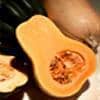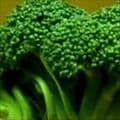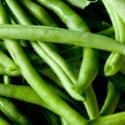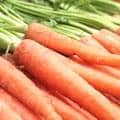Top 20 Vegetables Highest in Calcium

Calcium is a mineral necessary for the growth and maintenance of strong bones, strong teeth, nerve signaling, muscle contraction, and secretion of certain hormones and enzymes. (1,2,3,4)
Calcium is an electrolyte, and a deficiency in calcium can lead to numbness in the fingers and toes, muscle cramps, convulsions, lethargy, loss of appetite, and abnormal heart rhythms. (5,6) A long-term calcium deficiency can lead to bone loss (osteopenia) and fragile bones (osteoporosis). (7) Vitamin D and Vitamin K are also important nutrients for preventing osteoporosis. (7)
Finding calcium in vegetables and fruits is a concern for vegans, people on a raw food diet, or people who simply want to eat a varied plant-based diet. While there is some evidence that oxalates in vegetables can hinder calcium absorption, they are still a good source of calcium. Kale shows similar calcium absorbability to that of milk, (8) and soybeans are also a good source. (9) For more, see the section on calcium absorption.
Vegetables high in calcium include collard greens, turnip greens, kale, mustard greens, beet greens, bok choy, okra, Swiss chard, and broccoli raab. The daily value (DV) for calcium is 1300mg. (10,11)
Note: Spinach and collard greens are high in both calcium and oxalates. An estimated 5% of the calcium is absorbed from spinach vs 40% from kale. (12,8) For this reason, spinach and collard greens are omitted from this curated list.
Below is a list of high-calcium vegetables by common serving size, for more see the list of high-calcium fruits and high-calcium foods.
You can also see 200 vegetables high in calcium using the nutrient ranking tool.
List of Vegetables High in Calcium
 1 Turnip Greens
1 Turnip Greens| Calcium per Cup Cooked | Calcium per 100g | Calcium per 200 Calories |
|---|---|---|
| 197mg (15% DV) | 137mg (11% DV) | 1370mg (105% DV) |
 2 Kale
2 Kale| Calcium per Cup Cooked | Calcium per 100g | Calcium per 200 Calories |
|---|---|---|
| 172mg (13% DV) | 132mg (10% DV) | 943mg (73% DV) |
 3 Mustard Greens
3 Mustard Greens| Calcium per Cup | Calcium per 100g | Calcium per 200 Calories |
|---|---|---|
| 165mg (13% DV) | 118mg (9% DV) | 908mg (70% DV) |
 4 Beet Greens
4 Beet Greens| Calcium per Cup Cooked | Calcium per 100g | Calcium per 200 Calories |
|---|---|---|
| 164mg (13% DV) | 114mg (9% DV) | 844mg (65% DV) |
 5 Pak-Choi (Bok Choy)
5 Pak-Choi (Bok Choy)| Calcium per Cup Cooked | Calcium per 100g | Calcium per 200 Calories |
|---|---|---|
| 158mg (12% DV) | 93mg (7% DV) | 1550mg (119% DV) |
 6 Okra
6 Okra| Calcium per Cup Cooked | Calcium per 100g | Calcium per 200 Calories |
|---|---|---|
| 123mg (9% DV) | 77mg (6% DV) | 700mg (54% DV) |
 7 Swiss Chard
7 Swiss Chard| Calcium per Cup Cooked | Calcium per 100g | Calcium per 200 Calories |
|---|---|---|
| 102mg (8% DV) | 58mg (4% DV) | 580mg (45% DV) |
 8 Broccoli Raab (Rapini)
8 Broccoli Raab (Rapini)| Calcium per Cup Cooked | Calcium per 100g | Calcium per 200 Calories |
|---|---|---|
| 100mg (8% DV) | 118mg (9% DV) | 944mg (73% DV) |
 9 Podded Peas
9 Podded Peas| Calcium per Cup Cooked | Calcium per 100g | Calcium per 200 Calories |
|---|---|---|
| 94mg (7% DV) | 59mg (5% DV) | 227mg (17% DV) |
 10 Acorn Squash
10 Acorn Squash| Calcium per Cup Cooked | Calcium per 100g | Calcium per 200 Calories |
|---|---|---|
| 90mg (7% DV) | 44mg (3% DV) | 157mg (12% DV) |
 11 Butternut Squash
11 Butternut Squash| Calcium per Cup Cooked | Calcium per 100g | Calcium per 200 Calories |
|---|---|---|
| 84mg (6% DV) | 41mg (3% DV) | 205mg (16% DV) |
 12 Parsley
12 Parsley| Calcium per Cup | Calcium per 100g | Calcium per 200 Calories |
|---|---|---|
| 83mg (6% DV) | 138mg (11% DV) | 767mg (59% DV) |
 13 Sweet Potatoes
13 Sweet Potatoes| Calcium per Cup Mashed | Calcium per 100g | Calcium per 200 Calories |
|---|---|---|
| 77mg (6% DV) | 30mg (2% DV) | 59mg (5% DV) |
 14 Cabbage
14 Cabbage| Calcium per Cup Cooked | Calcium per 100g | Calcium per 200 Calories |
|---|---|---|
| 72mg (6% DV) | 48mg (4% DV) | 417mg (32% DV) |
 15 Celeriac
15 Celeriac| Calcium per Cup | Calcium per 100g | Calcium per 200 Calories |
|---|---|---|
| 67mg (5% DV) | 43mg (3% DV) | 205mg (16% DV) |
 16 Broccoli
16 Broccoli| Calcium per Cup Cooked | Calcium per 100g | Calcium per 200 Calories |
|---|---|---|
| 62mg (5% DV) | 40mg (3% DV) | 229mg (18% DV) |
 17 Brussels Sprouts
17 Brussels Sprouts| Calcium per Cup Cooked | Calcium per 100g | Calcium per 200 Calories |
|---|---|---|
| 56mg (4% DV) | 36mg (3% DV) | 200mg (15% DV) |
 18 Soybean Sprouts
18 Soybean Sprouts| Calcium per Cup Cooked | Calcium per 100g | Calcium per 200 Calories |
|---|---|---|
| 55mg (4% DV) | 59mg (5% DV) | 146mg (11% DV) |
- 1 cup of boiled soybeans (edamame) provides 13% DV (175mg) of calcium
See all beans and lentils high in calcium.
 19 Green (Snap) Beans
19 Green (Snap) Beans| Calcium per Cup Cooked | Calcium per 100g | Calcium per 200 Calories |
|---|---|---|
| 55mg (4% DV) | 44mg (3% DV) | 251mg (19% DV) |
 20 Carrots (Cooked)
20 Carrots (Cooked)| Calcium per Cup Cooked | Calcium per 100g | Calcium per 200 Calories |
|---|---|---|
| 47mg (4% DV) | 30mg (2% DV) | 171mg (13% DV) |
How Much Calcium Do You Need Everyday?
The daily value (%DV) for Calcium is 1300mg and is a general target intended for most people. The Recommended Daily Allowance (RDA) shows specific targets by age and gender. The RDA for Calcium is between 800mg - 1300mg for most people.
| Life Stage | RDA |
|---|---|
| Children | |
| 1-3 years old | 700mg |
| 4-8 years old | 1000mg |
| Males | |
| 9-18 years old | 1300mg |
| 19-70 years old | 1000mg |
| 70+ years old | 1200mg |
| Females | |
| 9-18 years old | 1300mg |
| 19-50 years old | 1000mg |
| 50+ years old | 1200mg |
| Pregnancy | |
| 14-18 years old | 1300mg |
| 19-50 years old | 1000mg |
| Lactation | |
| 14-18 years old | 1300mg |
| 19-50 years old | 1000mg |
What Affects Calcium Absorption?
- Amount of Calcium In Your Body - When previous consumption of calcium is low, your body will naturally absorb more calcium to compensate for the difference. (13)
- Vitamin D Intake - Vitamin D is critical for the absorption and regulation of calcium. (14,15) It can be found in foods or created by exposing skin to sunshine.
- Age - Calcium absorption declines with age, particularly for women over 70 and men over 50. (16,17)
- Pregnancy - Pregnant women absorb more calcium. (18)
- Phytic and Oxalic Acid - The absorption of calcium from foods low in oxalates and phytic acid can be 20-40% as is true for milk and kale. (19,20) While oxalic acid and phytic acid does hinder calcium absorption it does not block it altogether. For example, 5% of the calcium in spinach is absorbed (21), while 30% of the calcium in soybeans is absorbed (22). Still avoiding foods high in phytic and oxalic acid will benefit calcium absorption. High amounts of oxalic acid are found in plant foods like spinach, collard greens, sweet potatoes, rhubarb, and beans. Phytic acid is found in whole bread and wheat bran.
Should I Take Calcium Supplements?
Unless prescribed by a doctor or health care provider calcium supplementation may do more harm than good. (23,24)
Major concerns with the over-consumption of calcium include gastrointestinal disease, kidney stones, and even heart disease. (23,24)
Only take calcium supplements if directed by a doctor or health care provider, or if you are sure you are consuming less than the recommended 1000-1200mg per day.
Further, calcium supplements will not be effective without adequate intake of vitamin D. (16,17)
Do vegans and vegetarians need to take calcium supplements?
Determining supplemental calcium needs for vegans and vegetarians is complex, and there is no clear evidence suggesting that vegetarians or vegans on a diet with a variety of foods need to supplement. (25,26) Further, calcium and vitamin D are frequently added to vegan milk substitutes like soymilk, almond milk, and coconut milk. As such, vegans and vegetarians do not need to supplement with calcium unless directed by a health care provider or are sure they are consuming less calcium.
What Other Foods and Nutrients Can Help Make My Bones Stronger?
Several nutrients are necessary for strong bones in addition to calcium. These include vitamin D, vitamin K, magnesium, phosphorus, protein, boron, silicon, and fluoride. (27,28,26)
Further, resistance exercises like weight lifting, and even tennis, can help maintain strong bones and encourage bone development or create "osteogenic effects". (29,30,31)
About the Data
Data for the curated food lists comes from the USDA Food Data Central Repository.
You can check our data against the USDA by clicking the (Source) link at the bottom of each food listing.
Note: When checking data please be sure the serving sizes are the same. In the rare case you find any difference, please contact us and we will fix it right away.
About Nutrient Targets
Setting targets can provide a guide to healthy eating.
Some of the most popular targets include:- Daily Value (%DV) - The daily value (%DV) is a general guideline for consumption that will prevent deficiency of a particular nutrient in most people. The %DV refers to the percentage of an amount that's found in a single serving of a food. It also accounts for absorption factors. It is set by the U.S. FDA.
- Recommended Dietary Allowance (%RDA) - The RDA sets an average daily dietary intake level that is sufficient to meet the nutrient requirements of nearly all (97.5%) healthy individuals. It's more specific than the daily value, and varies by age and gender. The RDA is set by the US National Instutites of Health.
- Reference Dietary Intake (%RDI) -The reference dietary intake is similar to the recommended daily allowance, but is specific to age and gender. The RDI for amino acids is set by the U.N. World Health Organization.
- Adequate Intake (%AI) - This value is primarily used in reference to omega-3 and omega-6 fats. The Adequate Intake is set by the U.S. Institute of Medicine. Because there is less evidence to determine the ideal targets for consumption of these nutrients, the specific amount is considered to be less reliable. Using the term Adequate Intake, rather than one of the other terms, helps to emphasize that the ideal intake of that particular nutrient has not yet been scientifically determined.
See the Guide to Recommended Daily Intakes for more information.
Want to set your own targets? Sign up for an account and set custom targets in the daily meal planner.From the Nutrient Ranking Tool
Use the ranking tool links below to select foods and create your own food list to share or print.
- Foods High in Calcium
- Foods Low in Calcium
- Vegetables High in Calcium
- Fruits High in Calcium
- Vegetarian Foods High in Calcium
- Nuts High in Calcium
- Grains High in Calcium
- Beans High in Calcium
- Dairy High in Calcium
- Breakfast Cereals High in Calcium
- Fast Foods High in Calcium
View more nutrients with the nutrient ranking tool, or see ratios with the nutrient ratio tool.
Related
Data Sources and References
- Cashman KD. Calcium nutrition and metabolism Br J Nutr. 2002 May;87 Suppl 2:S169-77. doi: 10.1079/BJNBJN/2002534. 12088515
- Hanioka T, Ojima M, Tanaka K, Aoyama H. Low calcium intake is related to increased risk of tooth loss in men Gerodontology. 2007 Jun;24(2):87-92. doi: 10.1111/j.1741-2358.2007.00166.x. 17518955
- Ren ZL, Zuo PP. Calcium signalling: A common target in neurological disorders and neurogenesis J Pharmacol Sci. 2012;120(3):139-45. doi: 10.1254/jphs.12r06cp. Epub 2012 Oct 26. 23099323
- Steinberg JP, Leitner JW, Draznin B, Sussman KE. Calcium calmodulin and hormone secretion Diabetes. 1984 Apr;33(4):339-45. doi: 10.2337/diab.33.4.339. 6200377
- [No authors listed] Electrolytes Ann Clin Lab Sci. 2022 May;52(3):511-525. 35777803
- Palal B, Sinsakul M, Reutrakul S. Hypocalcemia in Malignancy - Unexpected but Common Case Rep Endocrinol. 2011;2011:370583. doi: 10.1155/2011/370583. Epub 2011 Oct 29. 22937282
- Murray TM. Importance of calcium, vitamin D and vitamin K for osteoporosis prevention and treatment CMAJ. 1996 Oct 1;155(7):935-9. 8837543
- Heaney RP, Weaver CM. Calcium absorption from kale Am J Clin Nutr. 1989 Oct;50(4):830-2. doi: 10.1093/ajcn/50.4.830. 2801588
- Jariwalla RJ. Soybean phytate content: effect on calcium absorption Am J Clin Nutr. 1992 Sep;56(3):609. doi: 10.1093/ajcn/56.3.609. 1503078
- U.S.FDA - Daily Value on the New Nutrition and Supplement Facts Labels
- Aloia JF. Dietary Reference Intakes for Calcium and Vitamin D J Clin Endocrinol Metab. 2011 Oct;96(10):2987-96. doi: 10.1210/jc.2011-0090. Epub 2011 Jul 27. 21795456
- Weaver CM, Heaney RP. Calcium absorbability from spinach Calcif Tissue Int. 1991 Oct;49(4):244-7. doi: 10.1007/BF02556212. 1760767
- Bronner F. Nutritional aspects of calcium absorption J Cell Biochem. 2003 Feb 1;88(2):387-93. doi: 10.1002/jcb.10330. 12520541
- Fleet JC, Reyes-Fernandez P. Vitamin D-Mediated Regulation of Intestinal Calcium Absorption J Steroid Biochem Mol Biol. 2020 Jun;200:105670. doi: 10.1016/j.jsbmb.2020.105670. Epub 2020 Apr 10. 32283207
- Lorenzo Sellares V, Torregrosa V. Vitamin D, calcium homeostasis and aging Nefrologia. 2008;28 Suppl 3:67-78. 19018742
- Sørensen OH, Lumholtz B, Lund B, Lund B, Hjelmstrand IL, Mosekilde L, Melsen F, Bishop JE, Norman AW. Impaired vitamin D metabolism with aging in women. Possible role in pathogenesis of senile osteoporosis J Clin Endocrinol Metab. 1982 Jun;54(6):1258-61. doi: 10.1210/jcem-54-6-1258. 6978888
- Lorenzo Sellares V, Torregrosa V. Age-related decline of bone mass and intestinal calcium absorption in normal males Nefrologia. 2008;28 Suppl 3:67-78. 19018742
- Gillies BR, Ryan BA, Tonkin BA, Poulton IJ, Ma Y, Kirby BJ, St-Arnaud R, Sims NA, Kovacs CS. Pregnancy up-regulates intestinal calcium absorption and skeletal mineralization independently of the vitamin D receptor J Bone Miner Res. 2018 Jan;33(1):16-26. doi: 10.1002/jbmr.3217. Epub 2017 Aug 2. 28686309
- Murray TM. Calcium bioavailability and its relation to osteoporosis CMAJ. 1996 Oct 1;155(7):935-9. 8837543
- Sotelo A, González-Osnaya L, Sánchez-Chinchillas A, Trejo A. Effects of fiber, phytic acid, and oxalic acid in the diet on mineral bioavailability Int J Food Sci Nutr. 2010 Feb;61(1):29-39. doi: 10.3109/09637480903213649. 20001762
- Weaver CM, Heaney RP. Calcium absorbability from spinach Calcif Tissue Int. 1991 Oct;49(4):244-7. doi: 10.1007/BF02556212. 1760767
- Jariwalla RJ. Soybean phytate content: effect on calcium absorption Am J Clin Nutr. 1992 Sep;56(3):609. doi: 10.1093/ajcn/56.3.609. 1503078
- [No authors listed] Calcium supplements: benefits and risks J Intern Med. 2016 Mar;279(3):311. doi: 10.1111/joim.12474. 26891945
- Daly RM, Ebeling PR. The good, the bad, and the ugly of calcium supplementation: a review of calcium intake on human health Nutrients. 2010 May;2(5):505-22. doi: 10.3390/nu2050505. Epub 2010 May 17. 22254038
- Tucker KL. The effects of vegetarian diets on bone health: A literature review Am J Clin Nutr. 2014 Jul;100 Suppl 1:329S-35S. doi: 10.3945/ajcn.113.071621. Epub 2014 Jun 4. 24898237
- Wengreen HJ, Munger RG, West NA, Cutler DR, Corcoran CD, Zhang J, Sassano NE. Calcium from plant sources is beneficial to lowering the risk of osteoporosis in postmenopausal Korean women J Bone Miner Res. 2004 Apr;19(4):537-45. doi: 10.1359/JBMR.040208. Epub 2004 Feb 9. 15005839
- Gennari C. Essential Nutrients for Bone Health and a Review of their Availability in the Average North American Diet Public Health Nutr. 2001 Apr;4(2B):547-59. doi: 10.1079/phn2001140. 11683549
- Francis RM. The role of nutrients in bone health, from A to Z Br J Nutr. 2008 Jan;99(1):155-9. doi: 10.1017/S0007114507791924. Epub 2007 Jul 19. 17640420
- Chachra D, Limeback H, Willett TL, Grynpas MD. The effects of fluoridated water on bone strength J Dent Res. 2010 Nov;89(11):1219-23. doi: 10.1177/0022034510376070. Epub 2010 Sep 21. 20858781
- Fagundes Belchior G, Kirk B, Pereira da Silva EA, Duque G. Effects of Resistance Exercise on Bone Health Eur Geriatr Med. 2020 Oct;11(5):715-724. doi: 10.1007/s41999-020-00355-6. Epub 2020 Jul 16. 32676865
- Calbet JA, Dorado C, DÃaz-Herrera P, RodrÃguez-RodrÃguez LP. Bone mineral content and density in professional tennis players Med Sci Sports Exerc. 2001 Oct;33(10):1682-7. doi: 10.1097/00005768-200110000-00011. 11581552
- Guadalupe-Grau A, Fuentes T, Guerra B, Calbet JA. The effects of progressive resistance training on bone density: a review Sports Med. 2009;39(6):439-68. doi: 10.2165/00007256-200939060-00002. 19453205
Try the recipe nutrition calculator, or daily meal planner.
Create a free account to log and track foods.

